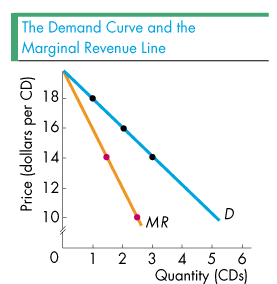
Perfectly Competitive Firm
Monopoly Firm
P = MR
P > MR
Chapter 12

The figure shows that the marginal revenue is less than the price because the marginal revenue line, MR, lies below the the demand line, D. Marginal revenue is less than the price because to sell more output, the owners must lower the price of their product. Thus, by selling one more unit of output (that is, one more CD), the owners gain additional revenue equal to the amount of the price. But, because the owners were forced to lower their price, the owners lose some revenue from customers who were already buying the product. This loss in revenue must be subtracted from the gain to get the net change, that is, to get the marginal revenue. Because the amount of revenue gained equals the price, subtracting something from it lowers the marginal revenue so that it less than the price.
A perfectly competitive firm does not need to lower the price of its product to sell more output. Hence, a perfectly competitive firm does not need to subtract anything from the gain in revenue when it sells another unit of output. As a result, for a perfectly competitive firm, the marginal revenue from selling another unit of output equals the price.
|
|
Perfectly Competitive Firm |
Monopoly Firm |
|
|
P = MR |
P > MR |
||
The fact that P > MR for a single-price monopoly is absolutely fundamental; if you do not learn this result, a horrible fate awaits you. The fact that P > MR is used throughout Chapter 12, from the beginning, where it is derived, to the end. To test your grasp of this key point, use Economics in Action and the Study Guide to accompany the textbook. In Economics in Action, work the questions in the Multiple Choice Quiz. In the Study Guide, answer True or False questions 8 and 9; Multiple Choice questions 10 and 11; and Short Answer question 4. Be sure not to miss any of these questions.
Would you like to study another chapter.